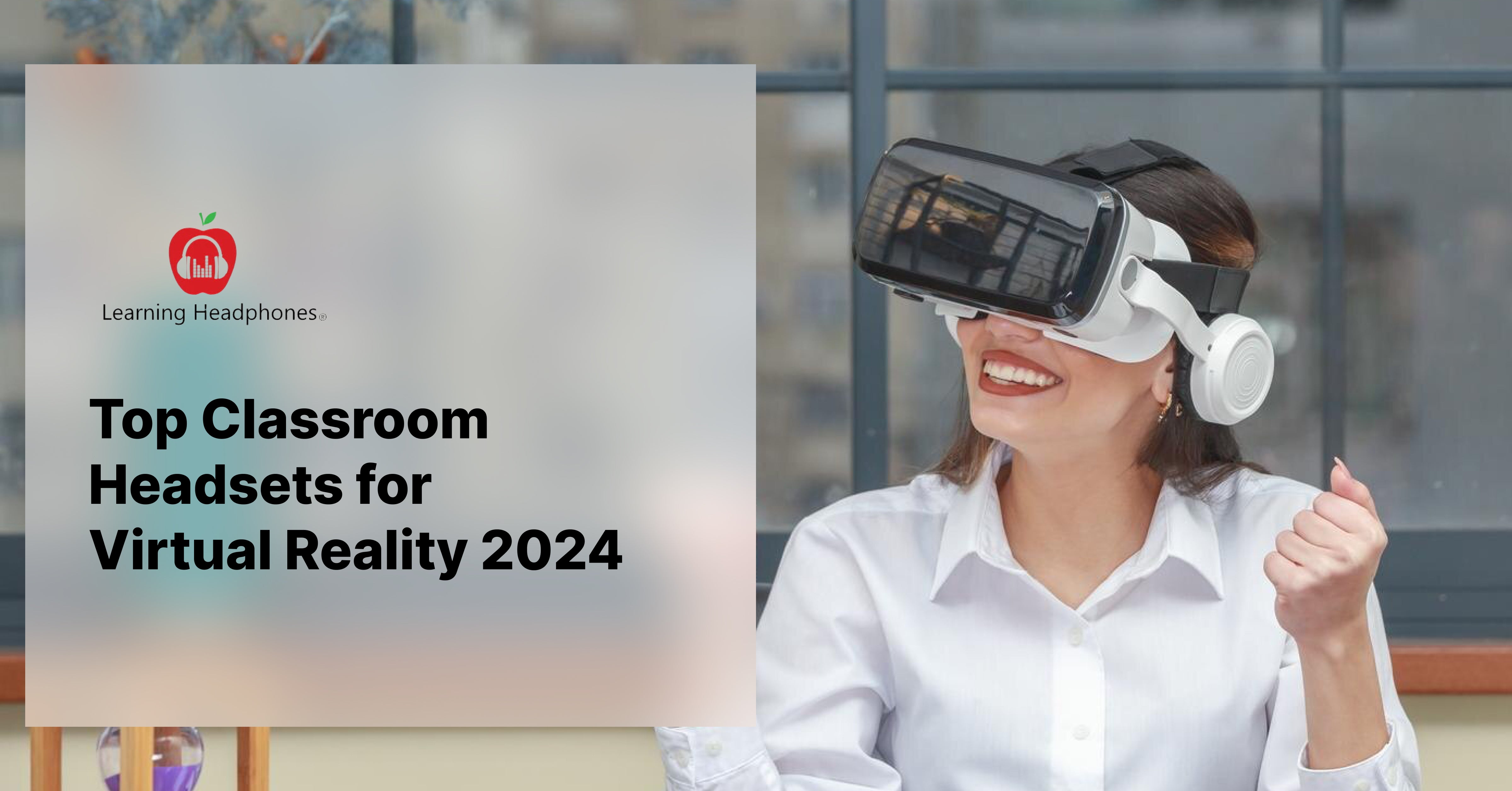A medida que la realidad virtual (RV) sigue revolucionando el sector educativo, es crucial equipar las aulas con los mejores auriculares para garantizar una experiencia de aprendizaje inmersiva y atractiva. En este artículo, exploraremos los mejores auriculares para el aula para realidad virtual en 2024, destacando sus características clave, beneficios e idoneidad para entornos educativos.
Auriculares AVID AE-08-1
Los auriculares AVID AE-08-1 son uno de los principales contendientes para el uso de realidad virtual en el aula. Con su diseño cómodo y sonido de alta calidad, estos auriculares permiten a los estudiantes sumergirse por completo en entornos de aprendizaje virtuales. La diadema ajustable garantiza un ajuste perfecto para varios tamaños de cabeza, lo que la hace adecuada para estudiantes de diferentes edades.

Los auriculares AVID AE-08-1 están diseñados teniendo en cuenta la durabilidad, lo que garantiza que puedan soportar los rigores del uso diario en el aula. Sus auriculares con aislamiento de ruido ayudan a los estudiantes a concentrarse en el contenido virtual, minimizando las distracciones del entorno circundante. Con su rendimiento confiable y precio asequible, los auriculares AVID AE-08-1 son una excelente opción para las escuelas que buscan implementar la realidad virtual en sus aulas.
Auricular AVID AE-25
El auricular AVID AE-25 es otra opción excelente para el aprendizaje de realidad virtual. Este auricular cuenta con un micrófono con cancelación de ruido, lo que permite una comunicación clara entre estudiantes y profesores durante las sesiones virtuales. El diseño sobre la oreja proporciona una excelente comodidad, incluso durante experiencias de realidad virtual prolongadas.

El auricular AVID AE-25 es compatible con una amplia gama de dispositivos de realidad virtual, lo que lo convierte en una opción versátil para las escuelas que utilizan diferentes plataformas de realidad virtual. Su construcción robusta y sus materiales fáciles de limpiar garantizan un rendimiento duradero, incluso con el uso frecuente por parte de varios estudiantes.
Auricular AE-75
Los auriculares AE-75 destacan por su excepcional calidad de audio y sus capacidades inmersivas. Con sus controladores de audio avanzados, estos auriculares ofrecen un sonido rico y detallado que mejora la experiencia de realidad virtual. Las almohadillas de felpa y la diadema ajustable brindan una comodidad superior, lo que permite a los estudiantes participar en el aprendizaje de realidad virtual durante períodos prolongados sin molestias.

Los auriculares AE-75 cuentan con una construcción duradera, con cables reforzados y materiales resistentes que pueden soportar las demandas de un salón de clases. Su conectividad plug-and-play hace que sea fácil de configurar y usar, lo que ahorra un valioso tiempo de clase.
Auriculares Revo
Los auriculares Revo son famosos por sus experiencias inmersivas de realidad virtual. Estos auriculares cuentan con pantallas de alta resolución y un amplio campo de visión, lo que permite a los estudiantes interactuar plenamente con el contenido virtual. El diseño ergonómico garantiza un ajuste cómodo, incluso para los estudiantes con gafas.

Los auriculares Revo vienen con controladores intuitivos que permiten interacciones naturales dentro de entornos virtuales. Los auriculares son compatibles con una variedad de aplicaciones y plataformas educativas de realidad virtual, lo que brinda a las escuelas flexibilidad en su plan de estudios de realidad virtual.
Auriculares USB-C
Los auriculares USB-C ofrecen comodidad y compatibilidad para las configuraciones modernas de las aulas. Los auriculares AE-35 USB-C y los auriculares AE-36 USB-C son excelentes opciones para las escuelas que utilizan dispositivos con puertos USB-C.


Estos auriculares ofrecen audio de alta calidad y comunicación de voz clara, esencial para un aprendizaje eficaz de la realidad virtual. Cuentan con diseños duraderos y cables que no se enredan, lo que garantiza un rendimiento fiable en el aula.
Para dispositivos sin puertos USB-C, el adaptador de auriculares USB-C a 3,5 mm proporciona una solución conveniente. Este adaptador permite a las escuelas utilizar sus auriculares de 3,5 mm existentes con dispositivos USB-C, lo que maximiza la compatibilidad y la flexibilidad.

Auriculares de prueba escolar
Para aplicaciones de realidad virtual en entornos de pruebas escolares, hay disponibles auriculares especializados para cumplir con los requisitos únicos. Los auriculares USB para pruebas escolares y los auriculares para pruebas escolares con conector de 3,5 mm están diseñados para proporcionar una experiencia de prueba sin distracciones.


Estos auriculares cuentan con auriculares que reducen el ruido y micrófonos transparentes, lo que garantiza que los estudiantes puedan concentrarse en el contenido de la prueba virtual y comunicarse de manera efectiva con los supervisores. La construcción duradera y los materiales fáciles de desinfectar los hacen ideales para escenarios de prueba de alto riesgo.
Tabla comparativa
| Auriculares de casco | Compatibilidad | Aislamiento de ruido | Micrófono | Durabilidad | Rango de precios |
|---|---|---|---|---|---|
| Auriculares AVID AE-08-1 | Extenso | Bien | No | Alto | $ |
| Auricular AVID AE-25 | Extenso | Excelente | Sí | Alto | $$ |
| Auricular AE-75 | Extenso | Excelente | Sí | Alto | $$$ |
| Auriculares Revo | Específico | Excelente | Sí | Alto | $$$$ |
| Auriculares AE-35 USB-C | Dispositivos USB-C | Bien | No | Alto | $$ |
| Auriculares AE-36 USB-C | Dispositivos USB-C | Bien | Sí | Alto | $$ |
| Auriculares USB para pruebas escolares | Dispositivos USB | Excelente | Sí | Alto | $$ |
| Auriculares de prueba escolar (enchufe de 3,5 mm) | Dispositivos de 3,5 mm | Excelente | Sí | Alto | $$ |
Factores a tener en cuenta a la hora de elegir unos auriculares para el aula
A la hora de seleccionar un auricular de aula para realidad virtual, hay que tener en cuenta varios factores:
- Comodidad: Busque auriculares con diademas ajustables, almohadillas de felpa y diseños livianos para garantizar la comodidad de los estudiantes durante las sesiones prolongadas de realidad virtual.
- Durabilidad: elija auriculares fabricados con materiales resistentes y cables reforzados para soportar los rigores del uso diario en el aula.
- Calidad de sonido: Opte por auriculares con controladores de audio de alta calidad que brinden un sonido envolvente y una comunicación de voz clara.
- Compatibilidad: asegúrese de que los auriculares sean compatibles con los dispositivos y plataformas de realidad virtual utilizados en el plan de estudios de su escuela.
- Higiene: Considere la posibilidad de usar auriculares con materiales fáciles de limpiar y almohadillas extraíbles para mantener una higiene adecuada en un entorno de aula compartida.
Beneficios de la realidad virtual en la educación
La realidad virtual ofrece numerosos beneficios en el sector educativo:
- Aprendizaje inmersivo: La realidad virtual brinda a los estudiantes experiencias inmersivas que mejoran la comprensión y la retención de conceptos complejos.
- Compromiso: El contenido interactivo de realidad virtual mantiene a los estudiantes comprometidos y motivados, promoviendo el aprendizaje activo.
- Accesibilidad: La realidad virtual permite a los estudiantes explorar lugares y fenómenos que de otro modo serían inaccesibles, como sitios históricos o simulaciones científicas.
- Desarrollo de habilidades: Las aplicaciones de realidad virtual pueden ayudar a los estudiantes a desarrollar habilidades prácticas, como la resolución de problemas, el pensamiento crítico y la colaboración.
- Aprendizaje personalizado: La realidad virtual permite experiencias de aprendizaje personalizadas adaptadas a las necesidades individuales de los estudiantes y a los estilos de aprendizaje.
Casos de estudio
Varias escuelas han implementado con éxito cascos de realidad virtual en sus aulas, con resultados positivos:
- Escuela Primaria Springdale: Al incorporar la realidad virtual en su plan de estudios de ciencias, la Escuela Primaria Springdale reportó una mayor participación de los estudiantes y mejores puntajes en los exámenes.
- Westville High School: Westville High School utilizó la realidad virtual para crear excursiones virtuales, lo que permitió a los estudiantes explorar sitios históricos y monumentos culturales sin salir del aula.
- Instituto Técnico de Oakwood: El Instituto Técnico de Oakwood integró la realidad virtual en sus programas de capacitación vocacional, lo que permitió a los estudiantes practicar habilidades del mundo real en un entorno seguro y simulado.
Preguntas frecuentes
-
P: ¿Cómo desinfecto los auriculares entre el uso de los estudiantes?
R: La mayoría de los auriculares vienen con almohadillas extraíbles que se pueden limpiar fácilmente con toallitas desinfectantes. Siga las pautas del fabricante para una limpieza y desinfección adecuadas. -
P: ¿Pueden los estudiantes usar anteojos mientras usan auriculares de realidad virtual?
R: Muchos cascos de realidad virtual, como los auriculares Revo, están diseñados para acomodar a los estudiantes con gafas. Busque auriculares con distancia de lente ajustable o espacio adicional para anteojos. -
P: ¿Cuánto tiempo pueden los estudiantes usar de manera segura los auriculares VR en una sola sesión?
R: Se recomienda limitar las sesiones de realidad virtual a 20-30 minutos a la vez, con descansos intermedios para evitar la fatiga visual y el mareo.
El futuro de la realidad virtual en la educación
A medida que la tecnología de realidad virtual continúa avanzando, podemos esperar experiencias educativas aún más inmersivas e interactivas. Algunos desarrollos potenciales incluyen:
- Retroalimentación háptica: Los auriculares con retroalimentación háptica permitirán a los estudiantes experimentar sensaciones táctiles, mejorando el realismo de las simulaciones virtuales.
- VR colaborativa: Las plataformas avanzadas de VR permitirán a los estudiantes colaborar e interactuar entre sí en espacios virtuales compartidos, fomentando el trabajo en equipo y las habilidades sociales.
- Aprendizaje adaptativo: Los sistemas de realidad virtual aprovecharán la inteligencia artificial para adaptar el contenido y los niveles de dificultad en función del rendimiento individual de los estudiantes, proporcionando experiencias de aprendizaje personalizadas.
Conclusión
Elegir los auriculares de aula adecuados para la realidad virtual es crucial para proporcionar a los estudiantes una experiencia de aprendizaje inmersiva y eficaz. Al tener en cuenta factores como la comodidad, la durabilidad, la calidad del sonido y la compatibilidad, las escuelas pueden seleccionar los mejores auriculares para sus necesidades específicas.
Los mejores auriculares para el aula para realidad virtual en 2024, como los auriculares AVID AE-08-1, los auriculares AVID AE-25, los auriculares AE-75 y los auriculares Revo, ofrecen una gama de características y beneficios que se adaptan a diferentes requisitos educativos. Los auriculares USB-C y los auriculares de pruebas escolares ofrecen opciones adicionales para configuraciones de aula y escenarios de prueba específicos.
A medida que la realidad virtual continúa transformando la educación, invertir en auriculares de calidad será esencial para que las escuelas aprovechen todo el potencial de esta tecnología innovadora. Al proporcionar a los estudiantes experiencias de aprendizaje inmersivas, atractivas y accesibles, la realidad virtual tiene el poder de revolucionar la forma en que enseñamos y aprendemos en el aula.



